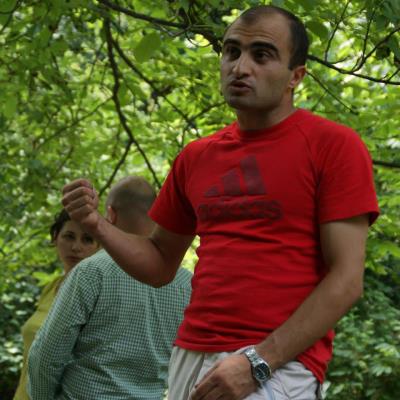Men are back
Anush Melkonyan, 22, Teghut resident, has been engaged in environmental issues and is currently working in Yerevan. Several years ago, when a struggle against operation of the copper-molybdenum mine in Lori region was launched, she set up an environmental public organization. Having noticed nothing bad in the mine’s work, she closed down her organization and moved to the capital.
“When I was a little girl, there were no men in the village. They all, including my father, worked abroad. But now they have returned back. It is good that the mine is operating, since almost all families are employed there. Earlier, higher education institution graduates had no jobs and had to stay at home, whereas they can find jobs now, Anush claims.
It should be noted that 1300 people are employed at “Teghut CJSC, residents of Lori region total 90% of workers, including 250 from Shnogh, 150 – from Teghut. The average wage amounts to AMD 315000 (approx. US$700), including taxes.
In the opinion of Arthur Grigoryan, a member of the Teghut Protection Civil Initiative, people want to have jobs and they get them, but they can’t even imagine how their life is going to change. Grigoryan has been struggling for the mine closure for several years. “The mine is actually more harmful than beneficial. It is overestimated,- says Arthur.

The existence of mine has some positive aspects as well. It is impossible not to notice newly asphalted roads, that are uncommon for Armenian villages, waste bins at every one hundred meter distance, that are cleared daily.
Stormy discussions on the need to cut down part of the forest have been held since the day the disputes over the mine began. Many ecologists, including local, and the mine’s management, do not consider deforestation to be a problem. “Teghut company claims, 415,7 ha. of trees have been planted, mainly in Lori region, instead of the fallen trees on 194,4 ha. area Besides, fruit trees will be planted on 180 ha. area in Shnogh and Teghut villages.
Shnogh-Debed-Kura-Caspian sea direct water link
On August 5 this year, Seiran Minsyan, water ecosystems expert at Chemical Physics Institute of the National Academy of Sciences of AR, presented results of the research “Water Dynamics in the Shogh River in 2009-2016. According to the research findings, as a result of negative impact of Teghut mine complex, the river, which ranked “good turned out to be in the “risk zone within 3-4 years and has been included in the fifth “poor class.
It should be noted that the Shnogh river is the Debed river’s tributary, which flows into the Kura (Georgia), which, in turn, runs into the Caspian Sea (Azerbaijan).
“Neighboring Georgia may demand from Armenia a pretty sum to reimburse the environment pollution. The state will pay this sum at the expense of taxes, it means, we will pay, but not the company, activist Arthur Grigoryan notes.
“Vallex Group press-secretary responded that the integrated works was a single enterprise in Armenia, working according to a principle of a closed production water circuit and leakage was impossible. “Water in the Shnogh River was tested for dynamic of molybdenum quantity, but undesirable difference in data was not observed.
Meanwhile, according to activist Arthur Grigoryan, they know from reliable sources that there was a leakage from the tailing pond at the first stage of operation. “Later, the company stated everything was in order, everything had been repaired, but no tests and researches were conducted and the reliability of their statements is doubtful.
For already three years, “Teghut CJSC has been in the list of enterprises, subject to examination by the State Environment Protection Inspection, as an institution, the activity of which may pose risk. The inspection was not conducted when the mine did not function. “Teghut mine started operating in December 2014. However, not a single inspection has been conducted since that time to study possible damage, that the mine may inflict to nature and endanger it. Moreover, on the government’s decree of July 30, 2015, the inspections were suspended in many risk-zone organizations, including in “Teghut CJSC.
Teghut village headman says: “We can’t check what damage the mine can inflict as I, as the village chief, have neither means nor funds for that. The mine brings an inspector itself and assures that all is clear. He, who makes the money has what he wants.
New explorations on new territories
“Teghut CJSC intends to carry out new exploration of the subsoil riches on the new areas. These territories belong to six villages, including Teghut and Shnogh. Members of the Teghut Protection Civil Initiative believe, this time villagers will not give in, having realized what consequences mine’s extension may lead to.
180 residents of Teghut village have land plots on the new territory. “I was asked to give a preliminary permission, I did not give it. I said I would allow to carry out exploration only in case all owners were consent. If they allow, how can I swim against the stream, says Teghut village chief.
“Vallex Group press-secretary noted: “Our Company is not accustomed to protests against our activity by residents of the neighboring villages. Until recently, any counteraction was out of question. On the contrary, our activity was always welcomed and promoted.
Indeed, the majority of residents are satisfied: there are no problems with the mine, roads have been repaired, men are employed and water is not of poor quality. When asked, what will happen then, they respond: “Then is in the future and we want to live today.
Published: 16.08.2016



















